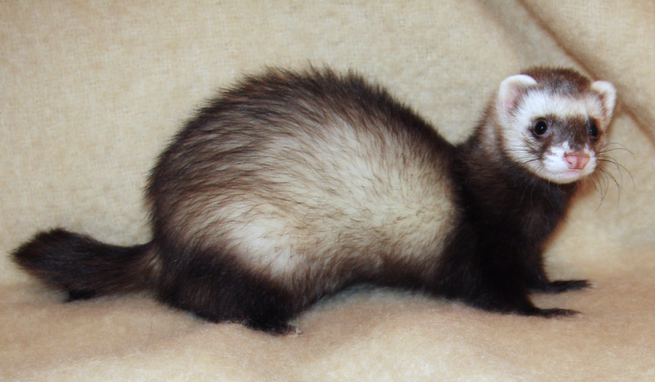
Main Difference
The main difference between Ferret and Weasel is that the Ferret is a subspecies of mammal and Weasel is a genus of mammals
-
Ferret
The ferret (Mustela putorius furo) is the domesticated form of the European polecat, a mammal belonging to the same genus as the weasel, Mustela of the family Mustelidae. They typically have brown, black, white, or mixed fur. They have an average length of 51 cm (20 in) including a 13 cm (5.1 in) tail, weigh about 1.5–4 pounds (0.7–2 kg), and have a natural lifespan of 7 to 10 years. Ferrets are sexually dimorphic predators with males being substantially larger than females.
Several other Mustelids also have the word ferret in their common names, including an endangered species, the black-footed ferret.
The history of the ferret’s domestication is uncertain, like that of most other domestic animals, but it is likely that ferrets have been domesticated for at least 2,500 years. They are still used for hunting rabbits in some parts of the world, but increasingly, they are kept only as pets.
Being so closely related to polecats, ferrets easily hybridize with them, and this has occasionally resulted in feral colonies of polecat-ferret hybrids that have caused damage to native fauna, especially in New Zealand. As a result, some parts of the world have imposed restrictions on the keeping of ferrets.
-
Weasel
A weasel is a mammal of the genus Mustela of the family Mustelidae. The genus Mustela includes the least weasels, polecats, stoats, ferrets, and mink. Members of this genus are small, active predators, with long and slender bodies and short legs. The family Mustelidae (which also includes badgers, otters, and wolverines) is often referred to as the “weasel family”. In the UK, the term “weasel” usually refers to the smallest species, the least weasel (M. nivalis).Weasels vary in length from 173 to 217 mm (6.8 to 8.5 in), females being smaller than the males, and usually have red or brown upper coats and white bellies; some populations of some species moult to a wholly white coat in winter. They have long, slender bodies, which enable them to follow their prey into burrows. Their tails may be from 34 to 52 mm (1.3 to 2.0 in) long.Weasels feed on small mammals and have from time to time been considered vermin because some species took poultry from farms or rabbits from commercial warrens. They do, on the other hand, eat large numbers of rodents. They can be found all across the world except for Antarctica, Australia, and neighbouring islands.
-
Ferret (noun)
An often domesticated mammal (Mustela putorius furo) rather like a weasel, descended from the polecat and often trained to hunt burrowing animals.
-
Ferret (noun)
The black-footed ferret, ver=161101.
-
Ferret (noun)
A diligent searcher.
-
Ferret (noun)
A tape of silk, cotton, or ribbon, used to tie documents, clothing, etc. or along the edge of fabric.
-
Ferret (verb)
To hunt game with ferrets.
-
Ferret (verb)
To uncover and bring to light by searching; usually to ferret out.
-
Weasel (noun)
The least weasel, Mustela nivalis.
-
Weasel (noun)
Any of the carnivorous mammals of the genus Mustela, having a slender body, a long tail and usually a light brown upper coat and light-coloured belly.
-
Weasel (noun)
The taxonomic family Mustelidae is also called the weasel family.
-
Weasel (noun)
A devious or sneaky person or animal.
-
Weasel (noun)
A type of yarn winder used for counting the yardage of handspun yarn. It most commonly has a wooden peg or dowel that pops up from the gearing mechanism after a certain number of yards have been wound onto the winder.
-
Weasel (verb)
To achieve by clever or devious means.
-
Weasel (verb)
To gain something for oneself by clever or devious means.
-
Weasel (verb)
To engage in clever or devious behavior.
